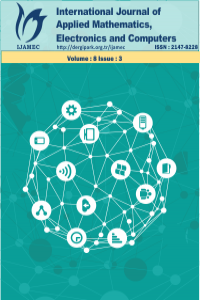Abstract
Vehicle detection and identification are very important functions in the field of traffic control and management. Generally, a study should be conducted on big data sets and area characteristics to get closer to this function. The aim is to find the most appropriate model for these data. Also, the model that is prepared for the data aims to recognize the factors on the image. In other words, it aims to assign factors to the right classes and differentiate them. A classification of the image is made in that way. In this study, a vehicle identification system, in which Fuzzy C-Means Algorithm is used for image segmentation and the Support Vector Machine is used for image classification, is presented. The currentness of these methods is their most important property. The obtained results show that the selected methods are applied successfully and effectively.
References
- T. Sufi,”A Case Study on Market Segmentation, Positioning and Classification of Multi-Brand Hotel Chains”, Emerging Dynamics of Indian Tourism and Hospitality, 2018, 87-97.
- O. Ozdemir, and A. Kaya,”Effect of parameter selection on fuzzy clustering”. Mehmet Akif Ersoy University Applied Scince Journal, vol. 2, pp. 22-33, 2018.
- M. M. Chi, Q. Qian Q., and J. A. Benediktsson “Cluster-based ensemble classification for hyperspectral remote sensing”, in Proc. IEEE IGARSS, 2018, 209–212.
- P. Kamavisdar, et al., “A Survey on Image Classification Approaches and Techniques”, International Journal of Advanced Research in Computer and Communication Engineering, vol. 2, Issue 1, 2008.
- J. C. Bezdek, “Pattern recognition with fuzzy objective function algorithms: Plenum”, New York, 1982, pp. 256.
- D. L. Pham, J. L. Prince, “Adaptive Fuzzy Segmentation of Magnetic Resonance Images”, IEEE Trans. Medical Imaging, vol. 18, pp. 737–752, 1999.
- N. Dhanachandra, K. Manglem and Y. J. Chanu, “Image segmentation using k-means clustering algorithm and subtractive clustering algorithm”, Procedia Computer Science, vol.54, pp.764-771, 2015.
- C. Ambroise, G. Govaert, “Convergence of an EM-type algorithm for spatial clustering”, Pattern Recognition Letters vol. 19, pp. 919–927, 1998.
- T McInerney and D. Terzopoulos, “Deformable models in medical image analysis: A survey”, Medical Image Analysis, vol. 1, no. 2, pp. 91-108, 1996.
- D. Q. Zhang. and S. C. Chen, “Clustering in completed data using Kernelbased fuzzy cmeans algorthim”, Neural Processing Letters, vol.18, no. 3, pp. 155-162, 2003.
- F. Meyer and S. Beucher, “Morphology segmentation”, Journal Visual Communications and Image Representation, vol. 1, no. 1, pp. 21-26, 1990.
- H. Shamsi, et al, “A modified fuzzy c means clustering with spatial information for image segmentation” International journal of computer theory and engineering, IACSIT, 2012.
- A. Khwairakpam, D. Kandar, D., B. Paul, “Noise reduction in synthetic aperture radar images using fuzzy logic and genetic algorithm. Microsyst Technol vol. 25,pp. 1743–1752, 2019.
- J. Zhang and Z. Ma, “Hybrid Fuzzy Clustering Method Based on FCM and Enhanced Logarithmical PSO” Computational Intelligence and Neuroscience, vol.2020, 2020.
- R. Duda, and P. Hart, “Pattern classification and scene analysis”, Wiley-Interscience, New York, 1973.
- A. Seker A. and A. G. Yuksek, “Stacked Autoencoder Method for Fabric Defect Detection” Cumhuriyet Science Journal., vol. 38, no. 2, 2017.
- V. N. Vapnik, “The Nature of Statistical Learning Theory” Springer-Verlag, New York, 1995.
Abstract
References
- T. Sufi,”A Case Study on Market Segmentation, Positioning and Classification of Multi-Brand Hotel Chains”, Emerging Dynamics of Indian Tourism and Hospitality, 2018, 87-97.
- O. Ozdemir, and A. Kaya,”Effect of parameter selection on fuzzy clustering”. Mehmet Akif Ersoy University Applied Scince Journal, vol. 2, pp. 22-33, 2018.
- M. M. Chi, Q. Qian Q., and J. A. Benediktsson “Cluster-based ensemble classification for hyperspectral remote sensing”, in Proc. IEEE IGARSS, 2018, 209–212.
- P. Kamavisdar, et al., “A Survey on Image Classification Approaches and Techniques”, International Journal of Advanced Research in Computer and Communication Engineering, vol. 2, Issue 1, 2008.
- J. C. Bezdek, “Pattern recognition with fuzzy objective function algorithms: Plenum”, New York, 1982, pp. 256.
- D. L. Pham, J. L. Prince, “Adaptive Fuzzy Segmentation of Magnetic Resonance Images”, IEEE Trans. Medical Imaging, vol. 18, pp. 737–752, 1999.
- N. Dhanachandra, K. Manglem and Y. J. Chanu, “Image segmentation using k-means clustering algorithm and subtractive clustering algorithm”, Procedia Computer Science, vol.54, pp.764-771, 2015.
- C. Ambroise, G. Govaert, “Convergence of an EM-type algorithm for spatial clustering”, Pattern Recognition Letters vol. 19, pp. 919–927, 1998.
- T McInerney and D. Terzopoulos, “Deformable models in medical image analysis: A survey”, Medical Image Analysis, vol. 1, no. 2, pp. 91-108, 1996.
- D. Q. Zhang. and S. C. Chen, “Clustering in completed data using Kernelbased fuzzy cmeans algorthim”, Neural Processing Letters, vol.18, no. 3, pp. 155-162, 2003.
- F. Meyer and S. Beucher, “Morphology segmentation”, Journal Visual Communications and Image Representation, vol. 1, no. 1, pp. 21-26, 1990.
- H. Shamsi, et al, “A modified fuzzy c means clustering with spatial information for image segmentation” International journal of computer theory and engineering, IACSIT, 2012.
- A. Khwairakpam, D. Kandar, D., B. Paul, “Noise reduction in synthetic aperture radar images using fuzzy logic and genetic algorithm. Microsyst Technol vol. 25,pp. 1743–1752, 2019.
- J. Zhang and Z. Ma, “Hybrid Fuzzy Clustering Method Based on FCM and Enhanced Logarithmical PSO” Computational Intelligence and Neuroscience, vol.2020, 2020.
- R. Duda, and P. Hart, “Pattern classification and scene analysis”, Wiley-Interscience, New York, 1973.
- A. Seker A. and A. G. Yuksek, “Stacked Autoencoder Method for Fabric Defect Detection” Cumhuriyet Science Journal., vol. 38, no. 2, 2017.
- V. N. Vapnik, “The Nature of Statistical Learning Theory” Springer-Verlag, New York, 1995.
Details
| Primary Language | English |
|---|---|
| Subjects | Engineering |
| Journal Section | Research Article |
| Authors | |
| Publication Date | October 1, 2020 |
| Published in Issue | Year 2020 Volume: 8 Issue: 3 |



